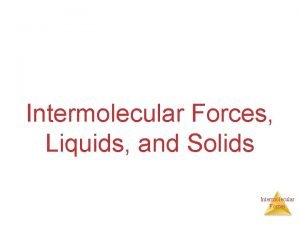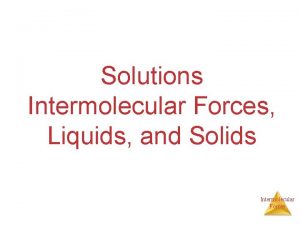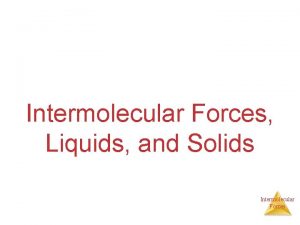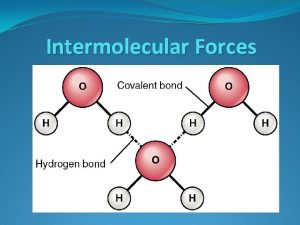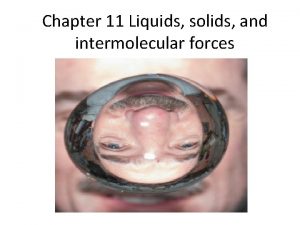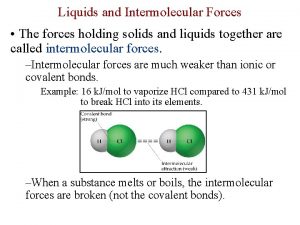Intermolecular Forces Solids and Liquids Chapter 11 Solids











- Slides: 11

Intermolecular Forces, Solids, and Liquids Chapter 11

Solids, Liquids, and Gases: A Comparison--Section 11. 1 n The physical state that a substance is most directly influenced by the amount of kinetic energy present in the substance

Intermolecular Forces Section 11. 2 n The physical properties of liquids are largely dominated by the effects of intermolecular forces ¨ Vapor pressure ¨ Boiling point ¨ Melting point

Dipole-dipole Forces n Similar to ion-dipole, but involves the alignment of dipoles of two different polar compounds ¨ The strength of dipole-dipole interactions increases as the strength of the dipole interactions increase

H-Bonding (Special Case of Dipole Interaction) n For a H-bond to form the following two criteria must be met: ¨A covalent bond containing hydrogen must exist (N-H, O-H, or F-H bond) n ¨A n H-bond donor lone pair of electrons must exist H-bond acceptor

London Dispersion Forces London dispersion forces exist for every single molecule (both polar and nonpolar) n They are the only intermolecular force present for nonpolar molecules or atoms, however n Strength of dispersion forces depends on the polarizability of the atom or molecule n

Polarizability n The polarizability of a molecule describes the extent to which the electron distribution can be altered creating an instantaneous dipole ¨ As a result, large atoms or molecules tend to have stronger dispersion forces than smaller

Surface Tension n Surface tension is the energy required to increase the surface area of a liquid ¨ In order to increase the surface area, IMFs must be overcome

Reminder Whenever physical properties of molecules are compared (i. e. boiling point, melting point, viscosity, vapor pressure, surface tension, etc. ), always think about IMFs. n Simply compare the forces present in each scenario and determine which is stronger n

Phase Changes Section 11. 4 n As the individual particles of a solid, liquid, or gas gain or lose kinetic energy, they may go through a series of phase changes

Heating Curves n Heating curve for H 2 O
 Intermolecular and intramolecular forces
Intermolecular and intramolecular forces Intermolecular forces vs intramolecular forces
Intermolecular forces vs intramolecular forces Covalent bond intermolecular forces
Covalent bond intermolecular forces Chapter 14 solids liquids and gases worksheet answers
Chapter 14 solids liquids and gases worksheet answers Kinetic molecular theory of liquids and solids
Kinetic molecular theory of liquids and solids Chapter 11 - states of matter: liquids and solids
Chapter 11 - states of matter: liquids and solids Thermal expansion and contraction examples
Thermal expansion and contraction examples Solids liquids and gases section 2 properties of fluids
Solids liquids and gases section 2 properties of fluids Solid liquid gas examples
Solid liquid gas examples Venn diagram of liquid and gas
Venn diagram of liquid and gas 20 examples of liquids
20 examples of liquids Combined gas law def
Combined gas law def












